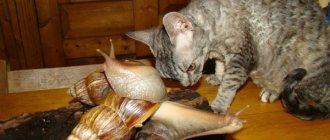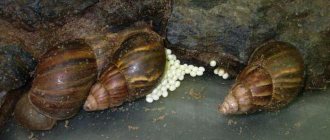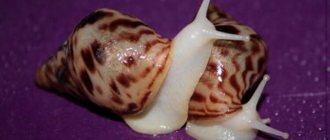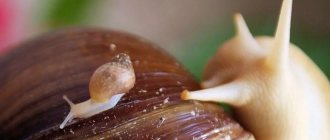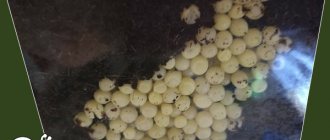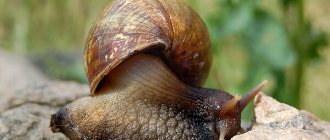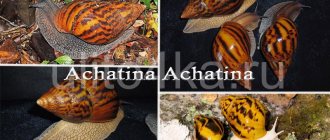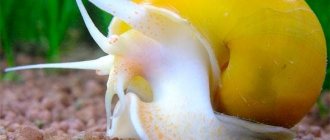Photo: UGC snails are unusual and incredibly interesting pets . From East African countries they spread throughout the world. It turns out that they not only grow up to 25 cm, but also lead an active lifestyle , are curious and are able to reach high speeds. Caring for them is as easy as shelling pears, just know the rules described in the article.
Keeping the Achatina snail (Terrarium)
A terrarium for Achatina can be made from a simple aquarium. The minimum size is 10 liters per snail. The larger the aquarium, the larger your snail will grow. The terrarium must have a lid, because snails can crawl out of it. It is advisable to arrange small holes in the lid for better gas exchange. As a last resort, you can simply lift the lid to create a small gap. You need to put bedding on the bottom of the aquarium. The bedding can be Begonia soil, or ideally a coconut substrate 5-7 cm thick. You can build a small bath with fresh water; Achatina loves to swim. The main thing is that the depth of the bath does not allow the snail to choke. In general, Achatina crawl well under water, but if it accidentally falls into the bath from above, a small snail can drown from fright. You also need to make sure that the bath does not turn over if the snail starts to burrow into the soil next to it, otherwise the water will spread out, which is not good.
The temperature and humidity required by Achatina are approximately the same as those in an ordinary city apartment. Soil moisture is determined empirically. If the snails sit on the walls of the terrarium all the time, it means there is too much water. If they prefer to be sealed (the evidence is hidden in the sink and closed with a lid), on the contrary, it is too dry. When the soil moisture is normal, snails crawl along its surface at night and often burrow into it during the day. To maintain humidity, it is enough to spray the soil and walls of the terrarium with a spray bottle twice a day.
To awaken a clogged snail, you can pour water over its mouth and carefully remove the cap, or simply place it in a terrarium with normal humidity. It is recommended to wash the terrarium at least once a week. The exception is a terrarium with a clutch of eggs, which must be cleaned without water so as not to change the humidity and not damage the clutch.
It is better to keep small snails without soil, covering them with cabbage or lettuce leaves, thereby increasing the chance of the snail finding food and making it easier to care for the terrarium.
Origin of the species and description
Photo: Achatina snail
Achatina or gastropod, belonging to the order of pulmonate snails, suborder of stalked-eyes, family of Achatna. The first gastropods inhabited our planet from the beginning of the Cretaceous period of the Mesozoic era. The oldest gastropod fossils are almost 99 million years old. The ancestors of gastropods were the ancient ammonite mollusks, which existed from the Devonian period to the Cretaceous period of the Mesozoic era.
Video: Achatina snail
Ammonites were very different from modern snails. Ancient snails were predatory and more similar to modern molluscs Nautilus pompilius. These mollusks swam freely in the water and were of enormous size. The species Achatina fulica was first described by the French zoologist Baron André Etienne Ferussac in 1821.
Achatina are a whole group of land snails which includes such species as:
- achatina reticulata;
- achatina Craveni;
- achatina glutinosa;
- achatina immaculata;
- achatina Panthera;
- achatina Tincta;
Achatina are large snails with a long shell of 8-15 cm, however, there are also very large specimens whose shell size is more than 25 cm. The snails have a canonical-shaped shell, twisted counterclockwise. On average there are about 8 turns on a shell. The color of a snail can vary and depends on what the snail eats. Basically, yellow and brown tones predominate in the color of Achatina. The shell often has a pattern of yellow and red-brown stripes.
Feeding the Achatina snail
It is better to feed as food is eaten and dried and remove any leftovers. Achatina eats vegetables, fruits and herbs, but in nature they do not refuse meat. Usually in captivity they are fed cabbage, carrots and cucumbers, but it is preferable to give them a more varied diet. This is necessary first of all so that at any moment you can switch to another available type of food. It is known that snails have certain food preferences, including many who prefer cucumbers and lettuce to other foods and, if they are fed only cucumbers from childhood, they often refuse to eat anything other than them, which can cause some inconvenience. Large snails can be given whole cores; they process food waste surprisingly quickly. Soft foods should be given only for a short period of time, otherwise they will flow and spread across the soil, causing it to become contaminated. It is generally not recommended to give soft foods to small snails. There was a case when snails buried themselves entirely in a banana and suffocated there. It is better to give very small newborn snails greens, grated carrots, and after a few days lettuce and an apple.
Can:
Fruits: apple, apricots, pineapple, avocado, bananas, pear, wild strawberry, strawberry, cherry, mango, papaya, plums, bunch of grapes, figs, watermelon, melon.
Vegetables: pumpkin, rutabaga, zucchini, broccoli, champignons, lettuce, cucumber, potatoes (boiled), carotel carrots, red peppers, celery, spinach, tomato, cabbage leaves.
Beans, peas (cooked or fresh), oatmeal.
Other: mushrooms, meadow plants/trees, nettles, daisy flowers, elder flowers, clover, dandelion, plantain, yarrow, sprouted oats, alfalfa, fruit tree blossoms (apple, apricot, peach...), bread (softened), milk (powdered) or natural), dairy/lactic acid products (without sugar, salt, spices), minced meat (minced meat, raw or boiled meat), egg (boiled), compound feed, meat and bone meal, peanuts (chopped), vegetable and meat baby food, gammarus.
It is important that the plants are not picked within the city, factories or enterprises, wastewater, or landfills. After you bring it home, rinse thoroughly in warm water!
You can’t (very important!):
Spicy, salty, sour, sweet, smoked, fried, pasta, potato eyes.
Useful tips from experts
Aquarists are convinced that nothing is easier than caring for Achatina - but only if a healthy snail has been purchased. To do this, you need to know how to choose the right tiger snails.
- You should not buy Achatina from your own hands; it is better to give preference to a pet store and observe the snail for some time: how it feeds, moves, how active it is.
- Before purchasing a terrarium, you should check the condition of the house, check how well it is ventilated, what its volume is, and whether the air is sufficiently humidified.
- Ideally, Achatina has a pedigree, which is noted in the registration documents.
- Achatina should be smooth, have a shell without damage, and it is better to buy when it reaches 2 - 2.5 months.
Remember that a properly selected and raised individual will bring significant benefits. For example, Achatina snails can be used in cosmetology. There are many recipes for masks that contain snail mucus. Beauty salons charge a lot of money for treating skin with Achatina snail. At home, such a procedure will not cost a penny.
If you have any questions about keeping giant Achatina snails at home, ask them in the comments
Effect of calcium on shellfish
Snails need calcium to build their shells. Calcium is a very common chemical element.
Lack of calcium in the snail's diet leads to curvature and deformation of the shell. The snail shell becomes softer due to lack of calcium; it is not protected from the environment. Since all internal organs are attached to the walls of the shell, any damage to it can lead to improper functioning of the organs or death. A mollusk that does not receive calcium from food, as a rule, lags behind in development: shell growth is disrupted or stops altogether, and puberty fails.
In order to prove how important calcium is for snails, I conducted an experiment.
Two groups of snails of the same age and species were taken and placed in the same conditions, but they were fed differently: some with food with added calcium, others with its complete absence.
Soon the snails of the second group stopped growing. It follows from this that calcium is indispensable for mollusks.
Snails kept in captivity receive calcium from sepia, eggshells, feed chalk, shell rock, gammarus, etc. For a more effective result, calcekashes are made. Calcekasha is a nutritious mixture made from various cereals with the addition of various sources of calcium; This product is served both dry and boiled.
Habitat
The lifestyle of snails and the ability to adapt to different living conditions have allowed them to spread almost throughout the world, with the exception of polar and arid desert regions. In nature, the greatest diversity of species is represented in the tropical and subtropical zones.
Luzhanka
Mountain and grape snails are grown artificially on special farms for subsequent consumption and production of cosmetics.
Breeding the Achatina snail (Reproduction of Achatina snails)
Achatina snails are hermaphrodites, that is, each individual has both male and female genital organs. In the absence of a partner, self-fertilization is possible, but it is quite rare.
The snail can store sperm for two years after mating, using it to fertilize maturing eggs. The number of eggs in a clutch is about 200 (in some cases up to 500); the snail can lay 5-6 clutches annually. The size of one egg is 4.5-5.5 mm, its shape resembles that of a chicken. Egg development is possible at temperatures from 22°C and lasts from several hours to 17 days.
Appearance and features
Photo: What does the Achatina snail look like?
Achatina are large terrestrial gastropods. The shell size of an adult is from 10 to 25 cm in length. The weight of the snail is about 250-300 grams. Under favorable conditions, the weight of the mollusk can reach 400 grams. The body is plastic, up to 16 cm in length, completely covered with a pattern of small wrinkles. The structure of the snail is conventionally divided into two functional parts: the cephalopodium—the head and leg of the mollusk—and the visceropallium (torso).
The head of the mollusk is quite large, located in the front of the body. The head has small horns, cerebral ganglia, eyes and a mouth. The snail's eyes are located at the ends of the tentacles. Snails see poorly. They can only distinguish the shapes of objects at a distance of 1 cm from the eyes. Able to distinguish between light intensity. They really don't like bright light. If sunlight hits the snail, the mollusk begins to hide. The oral cavity is well developed. Inside there is a tongue with spikes on it. Thanks to this structural feature, the snail can easily capture food with its tongue.
Interesting fact: Snails of this species have as many as 25 thousand teeth. The teeth are strong and made of chitin. With the help of teeth, the snail grinds hard pieces of food.
The snail's foot is strong, with a large wrinkled sole, with the help of which the snail can move along both horizontal and vertical surfaces. The glands of the snail secrete special mucus, which promotes gliding and better suction to the surface. The inner bag is protected by a strong shell. The snail has a fairly simple internal structure of organs: a heart, a lung and one kidney. The heart consists of the left atrium and ventricle surrounded by the pericardium. The blood is clear. The snail breathes air through its lungs and skin.
The shell of the mollusk is strong and durable. The number of turns corresponds to the age of the mollusk. The shell color of even mollusks of the same subspecies can vary greatly. The color of the shell depends on the snail’s diet and the conditions in which the individual lives. The average lifespan of these mollusks in the wild is 11 years; in captivity, these creatures can live much longer.
Interesting fact: Achatina, like many other snails, have the ability to regenerate. That is, the snail is able to regrow the lost part of the body.
Prohibited soils
❌ Sawdust
This type of bedding is not recommended by fish breeders, as sawdust (splinters) can injure the animal’s delicate body and esophagus.
❌ Sand
Not recommended due to the abrasive properties of sand. It can injure both the leg and Achatina’s house, get hidden under the sink, and cause discomfort. Once in the esophagus, it can clog the intestines and kill the mollusk.
❌ Pebbles
Small stones and pebbles are absolutely not suitable for lining the bottom of the terrarium. Achatina cannot burrow into it; they can be injured on hard stones if they accidentally fall.
❌ Clay
Pure clay is absolutely not suitable for a snail terrarium. It gets saturated with water, swells, gets dirty, and gets compressed. Once in the snail's stomach, it literally cements everything around it.
Offspring
Babies are born completely independent and do not require any special care. They are kept in the same way as their parents.
Young individuals are in good health and survive in poor housing conditions and insufficient nutrition. Even in such conditions, they begin to reproduce and lay eggs early.
The average lifespan of Achatina Fulika in nature is 5-7 years. When kept in captivity, poor conditions and frequent clutches lead to wear and tear on the body. And already at the age of 1.5-2 years, these gastropods experience old age and death.
Therefore, it is very important to create the necessary conditions for keeping Fulikas from a very early age and create the right diet. In addition, prevent early propagation and plant in a timely manner. In this case, you can increase the pet’s life to 3-4, or even more years. It is not recommended to transport, sell or suddenly change the conditions of keeping snails older than one and a half years old. Fouls, most often, react very negatively - they get stressed, go off the rails. Unfortunately, it is almost impossible to cure them and they die.
Young fowls need stable conditions, because any changes lead to growth stagnation and the appearance of corresponding marks - scars on the shell, which spoils the appearance of the pet. Achatina Fulica should be planted when young and kept individually until they are fully formed and have completed active growth. This is done to avoid early reproduction and premature aging and wear and tear of the body.
Young individuals are not picky eaters and will eat the offered treat. But they especially love cucumbers and lettuce.
Growing snail organisms require increased amounts of calcium. Don’t forget about protein supplements and grain mixtures.
